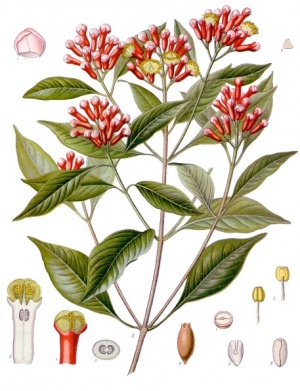Difference between revisions of "Madagascar Cloves"
CampMaster (talk | contribs) |
(Tags: Mobile edit, Mobile web edit) |
||
| (41 intermediate revisions by one other user not shown) | |||
| Line 1: | Line 1: | ||
| − | The clove tree, botanically named ''Syzygium aromaticum | + | '''The clove tree, botanically named ''Syzygium aromaticum'', is a member of the ''Myrtaceae'' family of evergreen trees, which typically grows in a humid tropical climate below 300m where there is no noticeable dry season. While clove farming has existed in Madagascar since 1820, clove became a number one cash-crop in 1990, providing an important contribution for Malagasy households, allowing farmers to supplement their income during shortfalls in food production.''' |
| − | + | {| class="imageTable" | |
| + | |- | ||
| + | |colspan="3" | [[File:Madagascar Cloves 004.jpg|600px]] | ||
| + | |- | ||
| + | |[[File:Madagascar Cloves 013.jpg|196px]] | ||
| + | |align="center"|[[File:Madagascar Cloves 014.jpg|196px]] | ||
| + | |align="right"|[[File:Madagascar Cloves 015.jpg|196px]] | ||
| + | |} | ||
| − | Clove | + | Clove originates from Maluku Island in Indonesia and was imported to Europe already in the 7th century. Upon discovery of Maluku Island by the Portuguese, the clove trade became monopolised by the Portuguese until driven out by the Dutch in the early 17th century. The trade thereafter became controlled by the Dutch until Pierre Poivre smuggled clove seedlings out of the country while organising expeditions on behalf of the French East India Company. Clove was consequently brought to Mauritius in 1770 and thereafter to La Reunion island. The first plants appeared in Madagascar on Sainte Marie island in the 1820s. |
| + | |||
| + | In less than a century, the clove tree was adopted by Malagasy farmers who quickly gained expertise in its cultivation and valorisation. In Madagascar, clove trees are grown for both purposes of clove spice and clove oil production. Farmers can produce clove spice from the flower buds or essential oil from the leaves, or alternate seasonally between the two. Clove oil is produced by hydrodistillation of the leaves, although essential oils derived from the clove bud and stem produce the highest yield. | ||
| + | |||
| + | {| class="imageTable" | ||
| + | |- | ||
| + | |colspan="3" | [[File:Madagascar Cloves 016.jpg|600px]] | ||
| + | |- | ||
| + | |[[File:Madagascar Cloves 001.jpg|196px]] | ||
| + | |align="center"|[[File:Madagascar Cloves 003.jpg|196px]] | ||
| + | |align="right"|[[File:Madagascar Cloves 008.jpg|196px]] | ||
| + | |} | ||
| + | |||
| + | By 1920/1930 Madagascar became a major producer and exporter of cloves and clove essential oil and is since the 1990s the world's leading exporter. | ||
| + | |||
| + | Clove production span along the east coast of Madagascar from Sambava to Fort Dauphin and especially throughout Analanjirofo (Malagasy for "clove-forest"), which makes up part of the Toamasina Province, including [[Tamatave]], [[Sainte Marie|Sainte Marie Island]] (Île Sainte-Marie), [[Mananara]] and [[Fenoarivo Atsinanana]] (Fénérive or Fénérive-Est) and the [[Soanierana Ivongo]] district. About 90% of Madagascar's clove production is concentrated around Mananara, Soanierana Ivongo and Fénérive Est. | ||
| + | |||
| + | The tree grows well in [https://en.wikipedia.org/wiki/Ferrallitisation ferralitic] tropical soil and usually gets between 10 and 12 metres but can get as tall as 20 metres. | ||
| + | |||
| + | [[File:Madagascar_Cloves_017.jpg|thumb|300px|left|Syzygium aromaticum]] | ||
| + | |||
| + | The plant flowers for the first time after 8-10 years and the trees are fully flowering at around 20 years. Cloves are the nail-like spikes which are unopened flower-buds. The name derives from the Latin word ''clavus'', meaning nail. Branches of clustered flower-buds are removed from the stems, then handpicked and sun-dried. Clove harvesting in Madagascar takes place between October and March.<!-- fact-check--> | ||
| + | |||
| + | Clove has a variety of culinary and non-culinary uses. As a spice, cloves are used in curries, spicy fruitcakes, sauerkraut and a wide range of cuisines as well as beverages such as red wines. | ||
| + | |||
| + | Non-food uses include mixing the spice with tobacco in Indonesian clove cigarettes called ''kretek'' which accounts for a large proportion of Madagascar's clove exports and world-production. | ||
| + | |||
| + | Clove oil is widely used as a base in perfumes, for example in ''l'Air du Temps'' by Nina Ricci and ''Opium'' by Yves Sain-Laurent. | ||
| + | |||
| + | Clove's main ingredient, eugenol, is a bioactive compound with anti-bacterial, fungicide, antiseptic, antioxidant, anaesthetic, analgesic, anti-inflammatory effects. It is furthermore used in aromatherapy and various traditional, human and veterinary medicines including dentistry, toothpaste... | ||
| + | |||
| + | Eugenol can, however, be toxic in relatively small doses. A dose of 5-10ml has been reported to be nearly fatal for a two-year-old. Additionally, clove oil can be used as an ant and mosquito repellent. | ||
| + | |||
| + | Clove is classified in three categories depending on harvesting and intended use: CGI - "Handpick", CG2 - "Prima", CG3 - "Courant" (ordinary), which applies to non-food use, such as the Indonesian ''kretek'' industry. | ||
| + | |||
| + | When exported, cloves in the Prima category should have less than 16% moisture level and weight at least 70mg. The right moisture level at the time of export is important to ensure minimum weight loss while the spice is on a shop shelf or kitchen cupboard without losing its spicy properties. Well prepared and packaged clove consignment should remain in good condition for at least two years. | ||
| + | |||
| + | Cloves from Madagascar are smaller than cloves from Sri-Lanka for example, with Madagascar's cloves having a stronger flavour making them suited for cooking, while Sri-Lankan cloves may be better for decorative pomanders. | ||
| + | |||
| + | == Additional information == | ||
| + | |||
| + | View all [[Madagascar Cloves photos]] | ||
| + | |||
| + | * https://www.madagascarspices.com/cloves.html | ||
| + | * https://en.wikipedia.org/wiki/Myrtaceae | ||
| + | * https://www.webmd.com/vitamins/ai/ingredientmono-251/clove | ||
| + | * [https://www.madagascarspices.com/admin/images/Danthuetal2014BFT.pdf The clove tree of Madagascar: A success story with an unpredictable future] - article in ''Bois et Forets des Tropiques'', January 2014 | ||
| + | * https://en.wikipedia.org/wiki/Clove | ||
| + | * http://www.idaromatic.com/cloves.htm | ||
| + | * https://www.importpromotiondesk.de/fileadmin/user_upload/Publikationen/factsheet/zutaten/cloves-in-germany.pdf | ||
| + | * https://www.ako-spice.com/cloves-a-big-thank-you-pierre-poivre/ | ||
Latest revision as of 18:25, 5 April 2020
The clove tree, botanically named Syzygium aromaticum, is a member of the Myrtaceae family of evergreen trees, which typically grows in a humid tropical climate below 300m where there is no noticeable dry season. While clove farming has existed in Madagascar since 1820, clove became a number one cash-crop in 1990, providing an important contribution for Malagasy households, allowing farmers to supplement their income during shortfalls in food production.
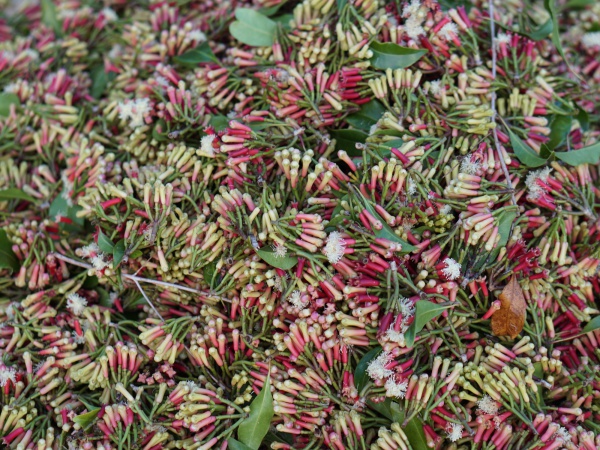
| ||
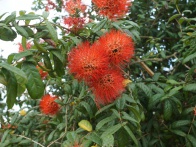
|
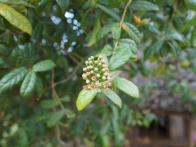
|
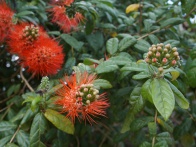
|
Clove originates from Maluku Island in Indonesia and was imported to Europe already in the 7th century. Upon discovery of Maluku Island by the Portuguese, the clove trade became monopolised by the Portuguese until driven out by the Dutch in the early 17th century. The trade thereafter became controlled by the Dutch until Pierre Poivre smuggled clove seedlings out of the country while organising expeditions on behalf of the French East India Company. Clove was consequently brought to Mauritius in 1770 and thereafter to La Reunion island. The first plants appeared in Madagascar on Sainte Marie island in the 1820s.
In less than a century, the clove tree was adopted by Malagasy farmers who quickly gained expertise in its cultivation and valorisation. In Madagascar, clove trees are grown for both purposes of clove spice and clove oil production. Farmers can produce clove spice from the flower buds or essential oil from the leaves, or alternate seasonally between the two. Clove oil is produced by hydrodistillation of the leaves, although essential oils derived from the clove bud and stem produce the highest yield.
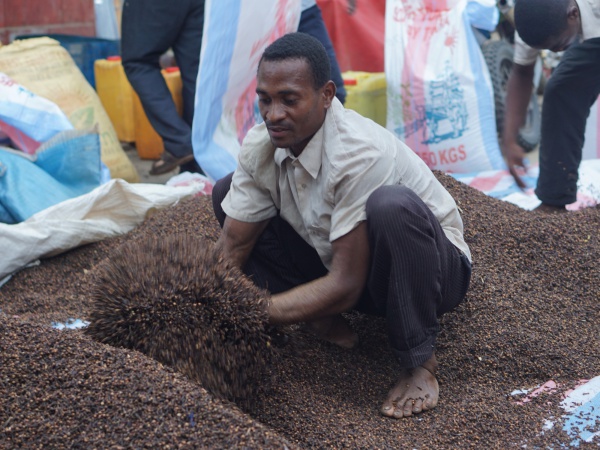
| ||
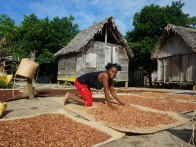
|
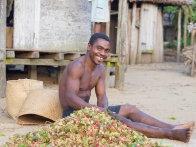
|
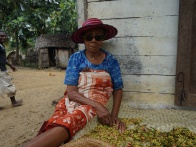
|
By 1920/1930 Madagascar became a major producer and exporter of cloves and clove essential oil and is since the 1990s the world's leading exporter.
Clove production span along the east coast of Madagascar from Sambava to Fort Dauphin and especially throughout Analanjirofo (Malagasy for "clove-forest"), which makes up part of the Toamasina Province, including Tamatave, Sainte Marie Island (Île Sainte-Marie), Mananara and Fenoarivo Atsinanana (Fénérive or Fénérive-Est) and the Soanierana Ivongo district. About 90% of Madagascar's clove production is concentrated around Mananara, Soanierana Ivongo and Fénérive Est.
The tree grows well in ferralitic tropical soil and usually gets between 10 and 12 metres but can get as tall as 20 metres.
The plant flowers for the first time after 8-10 years and the trees are fully flowering at around 20 years. Cloves are the nail-like spikes which are unopened flower-buds. The name derives from the Latin word clavus, meaning nail. Branches of clustered flower-buds are removed from the stems, then handpicked and sun-dried. Clove harvesting in Madagascar takes place between October and March.
Clove has a variety of culinary and non-culinary uses. As a spice, cloves are used in curries, spicy fruitcakes, sauerkraut and a wide range of cuisines as well as beverages such as red wines.
Non-food uses include mixing the spice with tobacco in Indonesian clove cigarettes called kretek which accounts for a large proportion of Madagascar's clove exports and world-production.
Clove oil is widely used as a base in perfumes, for example in l'Air du Temps by Nina Ricci and Opium by Yves Sain-Laurent.
Clove's main ingredient, eugenol, is a bioactive compound with anti-bacterial, fungicide, antiseptic, antioxidant, anaesthetic, analgesic, anti-inflammatory effects. It is furthermore used in aromatherapy and various traditional, human and veterinary medicines including dentistry, toothpaste...
Eugenol can, however, be toxic in relatively small doses. A dose of 5-10ml has been reported to be nearly fatal for a two-year-old. Additionally, clove oil can be used as an ant and mosquito repellent.
Clove is classified in three categories depending on harvesting and intended use: CGI - "Handpick", CG2 - "Prima", CG3 - "Courant" (ordinary), which applies to non-food use, such as the Indonesian kretek industry.
When exported, cloves in the Prima category should have less than 16% moisture level and weight at least 70mg. The right moisture level at the time of export is important to ensure minimum weight loss while the spice is on a shop shelf or kitchen cupboard without losing its spicy properties. Well prepared and packaged clove consignment should remain in good condition for at least two years.
Cloves from Madagascar are smaller than cloves from Sri-Lanka for example, with Madagascar's cloves having a stronger flavour making them suited for cooking, while Sri-Lankan cloves may be better for decorative pomanders.
Additional information
View all Madagascar Cloves photos
- https://www.madagascarspices.com/cloves.html
- https://en.wikipedia.org/wiki/Myrtaceae
- https://www.webmd.com/vitamins/ai/ingredientmono-251/clove
- The clove tree of Madagascar: A success story with an unpredictable future - article in Bois et Forets des Tropiques, January 2014
- https://en.wikipedia.org/wiki/Clove
- http://www.idaromatic.com/cloves.htm
- https://www.importpromotiondesk.de/fileadmin/user_upload/Publikationen/factsheet/zutaten/cloves-in-germany.pdf
- https://www.ako-spice.com/cloves-a-big-thank-you-pierre-poivre/
